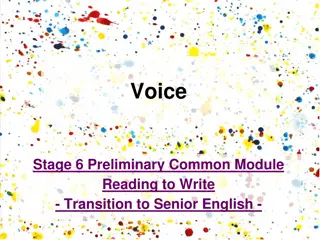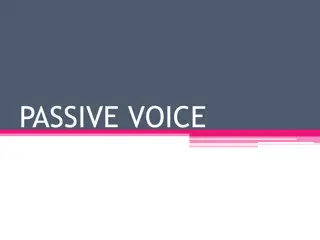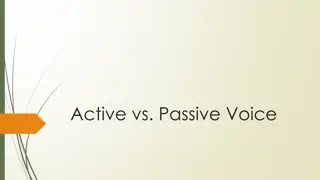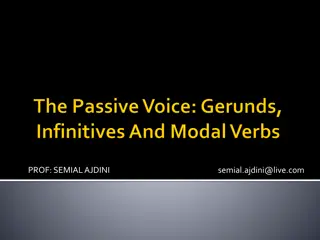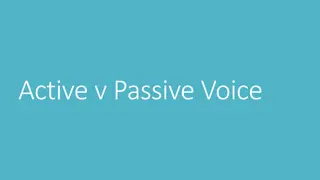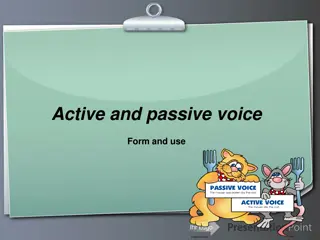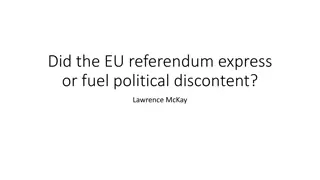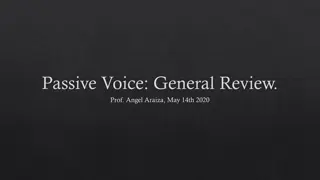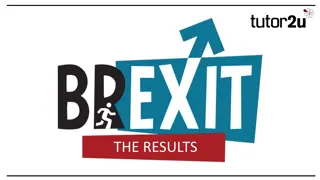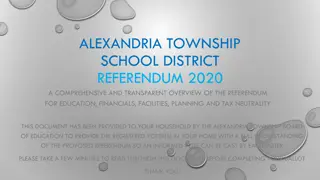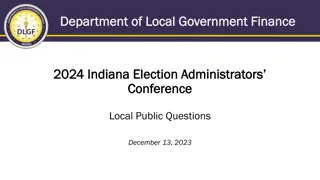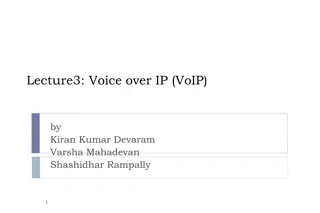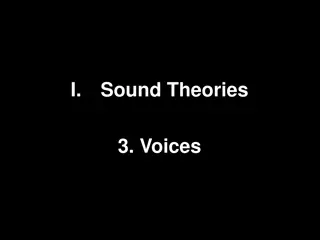Understanding the Legal Aspects of the Voice Referendum
Exploring the legal intricacies surrounding the Voice referendum, Professor Emerita Anne Twomey delves into the referendum procedure, timing, question formulation, and more. Through a clear breakdown, she dispels misconceptions and clarifies the legal foundations crucial to this important event.
Download Presentation

Please find below an Image/Link to download the presentation.
The content on the website is provided AS IS for your information and personal use only. It may not be sold, licensed, or shared on other websites without obtaining consent from the author. Download presentation by click this link. If you encounter any issues during the download, it is possible that the publisher has removed the file from their server.
E N D
Presentation Transcript
THE VOICE REFERENDUM AN EXPLANATION OF THE LEGAL ISSUES Professor Emerita Anne Twomey 29 June 2023
Introduction The Voice referendum largely raises issues of politics and social policy. But the debate has become confused because of various legal claims. In the first part of this talk I will explain the legal basics of the referendum, the background to the Voice and what the proposed amendment says and will do. In the second part, I will address some of the legal arguments made about the Voice and explain why the concerns are misconceived.
Referendum procedure The referendum procedure is set out in s 128 of the Constitution. To pass, a referendum needs a double majority: (a) a majority of valid votes across the country (including in the Territories); and (b) a majority of valid votes in a majority of States (i.e. four out of six States, excluding the Territories). If a referendum is supported by, eg, 62% of voters overall, but has majorities in only three States, it fails. Informal votes are not counted (although the Constitution is not express about this). Voting is compulsory (as required by statute, not the Constitution).
Referendum timing and materials S 128 says the referendum must be held not less than two months nor more than six months after its passage through Parliament. The referendum bill passed Parliament on 19 June. The most likely referendum dates are 14 or 21 October. A Yes/No pamphlet will be sent to all voters. Each side gets a maximum of 2000 words. The Yes case is prepared by a majority of those MPs who voted for the referendum, and the No case by a majority of MPs who voted against it. It must be submitted to the AEC within 4 weeks after the referendum bill is passed by Parliament and distributed to voters at least 2 weeks before the referendum is held: Referendum (Machinery Provisions) Act 1984 (Cth), s 11.
The Referendum Question Section 128 of the Constitution says that for a constitutional amendment to pass, a majority of the electors voting across Australia and a majority of electors voting in a majority of States must approve the proposed law . The form of the question is determined by the Referendum (Machinery Provisions) Act 1984 (Cth). It uses the long title of the proposed law to identify it. Voters will be asked: A Proposed Law: to alter the Constitution to recognise the First Peoples of Australia by establishing an Aboriginal and Torres Strait Islander Voice. Do you approve this proposed alteration? The voter then must write Yes or No in the box provided.
Background The Voice proposal was developed in response to the rejection of a previous proposal to constitutionalise an anti-racial discrimination provision. The idea was to flip the approach. Instead of going to court to challenge a law after it was made, it was proposed to seek to influence laws and policies before they were made. Instead of giving agency to lawyers and judges, it would put it back into the hands of Indigenous Australians. Each time their voices were heard, this would be an act of recognition. This would amount to active and continuing constitutional recognition, rather than just some words on a page.
Background The Voice proposal was first developed in 2014 by Noel Pearson, Greg Craven, Julian Leeser, Damien Freeman, Shireen Morris and me. It was later put to Aboriginal and Torres Strait Islander groups in dialogues across the country by the Referendum Council, along with a range of other proposals for constitutional reform. The Voice proposal was the most successful by a long way. It was confirmed as the key request (along with Treaty and Truth) at the national convention in Uluru in May 2017, resulting in the Uluru Statement from the Heart. It was later modified, numerous times, after various committee inquiries, until the Prime Minister announced a draft version at Garma in 2022, and was later modified again as a consequence of the work of the Constitutional Experts Group and the Referendum Working Group and the Solicitor-General.
The Proposed Amendment Chapter IX - Recognition of Aboriginal and Torres Strait Islander Peoples 129 Aboriginal and Torres Strait Islander Voice In recognition of Aboriginal and Torres Strait Islander peoples as the First Peoples of Australia: i. there shall be a body, to be called the Aboriginal and Torres Strait Islander Voice; ii. the Aboriginal and Torres Strait Islander Voice may make representations to the Parliament and the Executive Government of the Commonwealth on matters relating to Aboriginal and Torres Strait Islander peoples; iii. the Parliament shall, subject to this Constitution, have power to make laws with respect to matters relating to the Aboriginal and Torres Strait Islander Voice, including its composition, functions, powers and procedures.
The introductory words The introductory words provide formal recognition in the Constitution of Aboriginal and Torres Strait Islander peoples as the First Peoples of Australia . (John Howard s 1999 preamble referendum included recognition of Aborigines and Torres Strait Islanders [as] the nation s first people ). It is a statement of fact and an explanation for the Voice. It makes clear that the amendment is not being made because of race , but rather because Aboriginal and Torres Strait Islander peoples are the First Peoples of Australia and therefore have a unique place in Australia s cultural history and unique continuing legal rights, such as native title.
S 129(i) guaranteed existence S 129(i) requires the existence of the Voice, although it can only be given substance by a law enacted by Parliament under s 129(iii). Parliament could not be compelled to enact such a law it is a duty of imperfect obligation . But once the law is made that provides for the composition and functioning of the Voice, any law to repeal it, without providing a substitute Voice, could have its validity challenged in the courts. The Voice is constitutionally recognised as a body with its own capacity to make representations. It would therefore be a legal person, attracting the powers and rights of a legal person (eg to own property, employ people, enter into contracts, sue and be sued), unless legislation provides otherwise.
S 129(ii) guaranteed capacity The Voice may make representations to the Parliament and the Executive Government of the Commonwealth on matters relating to Aboriginal and Torres Strait Islander peoples . May is permissive. There is no obligation on the Voice to make representations regarding any particular matter. Representations means statements expressing a point of view on behalf of the represented group, including a complaint or a request. Representations can be made to Parliament or the Executive Government, but Parliament, under s 129(iii) can determine the procedure for this (eg requiring all representations to be tabled in Parliament, or sent to a Minister or particular agency). S 129(ii) contains no words imposing any obligation on Parliament or the Executive about considering or giving effect to these representations. S 129(ii) is merely facultative. But Parliament could not legislate to take away that faculty.
S 129(ii) the scope of representations The Voice may make representations about matters relating to Aboriginal and Torres Strait Islander peoples . Is this too broad? Should it be matters directly affecting Aboriginal and Torres Strait Islander peoples? It needs to be broad because many laws of general application have a greater or particular impact upon Indigenous Australians. If it were narrowed to matters directly affecting , it would result in endless litigation about where the line is drawn. This is why it was left broad to avoid litigation and to leave it to political pressures to ensure that the Voice focuses on relevant matters. Political pressures include: (a) limited resources; (b) the demands of Indigenous Australians that the Voice deal with pressing issues, not follies; and (c) Parliament s power to reconstitute the Voice if it fails to focus on what is needed.
S 129(iii) powers of Parliament S 129(iii) gives Parliament power to legislate to govern the composition and operation of the Voice and to confer on it other functions (eg interaction with State bodies). Parliament s power is subject to this Constitution . It is therefore subject to express limits and constitutional implications, such as the separation of powers and the implied freedom of political communication. Parliament could not, for example, confer legislative power on the Voice or abdicate its legislative power by requiring the approval of the Voice before passing particular laws, as this would be contrary to Ch I of the Constitution.
S 129(iii) powers of Parliament Sub-section 129(iii) is also subject to s 129(i) and s 129(ii), which means Parliament could not legislate to abolish the Voice (unless it replaced it with an equivalent body) and would not be able to abolish or restrict its ability to make representations to Parliament and the Executive Government on matters relating to Aboriginal and Torres Strait Islander peoples. Parliament could, however, regulate how the Voice makes such representations and could legislate about how the Executive interacts with the Voice eg if/when it should consult the Voice in advance, whether a representation by the Voice is a mandatory relevant consideration in making a decision, and how representations are to be recorded and publicly accessed.
Arguments I will address three arguments that are made about the Voice which give rise to legal issues They are that: 1. the amendment will introduce race into the Constitution and destroy the equality of treatment of all people under the Constitution; 2. the High Court will draw an implication from the Constitution which requires the Voice to be consulted in advance about everything and will make government unworkable; and 3. the amendment will give Indigenous Australians special rights under the Constitution that are not held by others.
1. It will introduce race into the Constitution and destroy equality of treatment An example of one of the many incorrect claims on the internet
Introducing race into the Constitution Race is already mentioned in our Constitution twice. It is mentioned in s 25 which punishes a State if it disqualifies people from voting on the basis of race, by reducing the representation of that State in Parliament. It is mentioned in s 51(xxvi) a power to make laws for the people of any race for whom it is deemed necessary to make special laws. Australians have not always been treated equally under the law. For example, people were excluded from voting at the federal level on a race basis for decades. The Constitution does not have 144 pages. The people making this claim seem to have been looking at some other Constitution.
The Constitution does not treat everyone the same The High Court has said that there is no general principle of equality in the Constitution and no implied principle of legal equality under the laws of the Commonwealth (Kruger (1997) at 44-5, 67, 113 and 154). Chief Justice Brennan said that inequality is contemplated by the race and aliens powers and that this destroys the argument that the Constitution requires legal equality irrespective of race. In Mulholland v AEC (2004), Chief Justice Gleeson pointed to the entrenched inequality in the Constitution that gives Tasmanians far greater representation in the Commonwealth Parliament than their population warrants, so that the value of a Tasmanian s vote is almost four times that of a NSW resident. That inequality is also reflected in the double majority in a referendum, where in 1977 the will of 62% of voters was defeated in a referendum because only 3 States voted Yes.
Substantive equality Inequality is also reflected in federal finance and the inclusion of s 96 of the Constitution. There is no requirement that the Commonwealth fund States equally according to population (even though there is a requirement that taxes be imposed equally across the States). Why? Substantive equality does not mean treating everyone the same. Relevant differences need to be taken into account. Those who are disadvantaged may need additional help to reach the same standard of services and opportunities as others. This is true both of the least populous States and of Indigenous Australians. Indigeneity is also a relevant difference that needs to be taken into account to achieve substantive equality.
Equality of opportunity to participate in the exercise of political sovereignty The High Court recognises that sovereignty in Australia is held by the people i.e. popular sovereignty. The Constitution guarantees that the people of Australia are able to enjoy equality of opportunity to participate in the exercise of political sovereignty (McCloy v NSW). That equality has to be substantive, rather than formal. Treating people the same, when there are genuine differences, does not result in equality or fairness. For example, to achieve substantive equality, some voices may need to be quietened (eg the rich) so that other voices can be heard (eg the disadvantaged). This means Parliament can cap political donations, because the uncontrolled use of wealth can undermine the practical enjoyment of popular sovereignty by others. (McCloy)
Equality can mean recognising difference and creating an equal playing field In a Canadian case (cited by the High Court), it was noted that there were two ways the State can equalise participation in the political system. First, the State can provide a voice to those who might otherwise not be heard. Second, the State can restrict the voices which dominate the political discourse so that others may be heard as well. (Harper v Canada) The Aboriginal and Torres Strait Islander Voice to Parliament and the Executive Government is proposed for the purpose of enhancing the voices of those who might otherwise not be heard, so that they can fully participate, with equality, in Australia s system of representative and responsible government, which finds its source in popular sovereignty. This is particularly important because of the special laws and policies made about Aboriginal and Torres Strait Islander peoples. It allows Indigenous voices to be heard about them.
2. The Voice should not be able to make representations to the Executive Government The most controversial aspect of the amendment is the power to make representations to the Executive Government. Why? Administrative law requires Ministers and other decision- makers to make decisions that affect individuals fairly. This includes taking into account relevant considerations. If they fail to do so, a court may require them to re-make the decision by a fair process. Under administrative law, however, a matter is only a mandatory relevant consideration if the statute conferring the decision-making power actually says so, or a court implies from the terms of the statute that this is necessarily intended.
Mandatory relevant considerations - example For example, s 10 of the Aboriginal and Torres Strait Islander Heritage Protection Act 1984 (Cth) requires that before a Minister makes a decision to protect a particular area, a notice is published in a local newspaper stating that the protection is being considered and inviting interested persons to make representations. Due consideration must be given by an official to those representations. The official prepares a report, and the representations must be forwarded with it to the Minister, who must also take them into consideration. If the Minister fails to do so, then a person could go to a court for judicial review and the court could require the Minister to re-make the decision following the correct process.
Mandatory relevant considerations matters for Parliament Such provisions already exist in abundance at the Commonwealth and State level, but have not stopped the ability of the Commonwealth and the States to function or resulted in massive litigation. It is up to Parliament to decide whether to impose such an obligation upon a decision-maker. If a court held that such an obligation was implied by the statutory provision, but Parliament disagreed, then Parliament could amend the legislation that confers the power so that there is no such obligation. Ultimately, Parliament retains its control over the issue.
Constitutional implications? Some have argued that the High Court will draw an implication from proposed s 129(ii) that any representation by the Voice is a mandatory relevant consideration in relation to all decisions made by government decision-makers that could fall within the category of matters relating to Aboriginal and Torres Strait Islander peoples . They add an obligation to advise the Voice in advance of making such a decision, provide the Voice with all relevant information about it, and provide the Voice with adequate time to make informed representations about it. The argument is that because this is a constitutional requirement, Parliament won t be able to control it.
Constitutional implications? Where would this implication come from? There is nothing in the text of the amendment. It is argued that the High Court might find that the power conferred upon the Voice to make representations to Parliament and the Executive Government would be ineffective if the Voice was not advised and informed in advance about proposed relevant exercises of legislative or executive power and if neither the Parliament nor the Executive was required to consider those representations and give adequate time for them to be made. Therefore, it is argued, it must be intended that the Voice be given the opportunity to make effective representations and that they have to be considered by Parliament and the Executive Government.
Constitutional implications? The answer is that the effectiveness of the Voice is intended to lie in politics rather than legal obligations. It is intended that Parliament be able to decide what kind of prior consultation might occur with the Executive Government and whether it is a mandatory relevant consideration to take a representation of the Voice into account when making a particular decision. This is made clear from: (a) the text of the amendment which imposes no obligations on Parliament or the Executive Government, but allows Parliament to legislate about such matters; (b) the context and history of the amendment; (c) the second reading speech and Explanatory Memorandum; (d) the Solicitor-General s opinion; (e) the report of the Joint Select Committee; and (f) (presumably) the Yes case.
A recent example Gerner v Victoria During the COVID-19 lock-downs in Victoria, Mr Gerner argued in the High Court that s 92 of the Constitution, which protects interstate intercourse (i.e. movement across State borders) also contains an implication of freedom of movement within a State. He argued that intra-state movement was necessary to give full effect to interstate movement (i.e. to get to the border, so you can freely cross the border). This was rejected by the High Court. Their Honours noted that this would be contrary to the terms of the Constitution, which expressly guarantee interstate movement, as distinct from intrastate movement. The Court stressed that if the text is explicit then it is conclusive in what it directs or forbids.
Gerner v Victoria The Court looked to the mischief at which s 92 was directed and concluded it was not directed at intrastate movement. The Court also looked at the Convention Debates of the 1890s, where it was stated that s 92 would not remove the powers of the States to prevent persons with contagious diseases from entering the State. Their Honours also pointed out that a broader form of words that would have covered movement throughout the Commonwealth was proposed and rejected in the course of the Convention Debates. The Court concluded: It would be a distinctly unsound approach to the interpretation of the constitutional text actually adopted by the framers to attribute to that text a meaning that they were evidently united in rejecting .
Applying Gerner to the Voice This unanimous High Court authority from 2020 suggests how the Court would approach the interpretation of the Voice amendment. It would focus primarily on the text but would also look to what was intended. It would take into account the fact that those involved in framing the amendment were united in rejecting any implication that the Voice must be advised in advance of a decision, given information and time to make adequate representations and that its representations must be considered. In addition to these barriers of text and intention, there are two others. They concern (a) the practicality of drawing such an implication; and (b) the previous approach of the Court to applying mandatory relevant considerations.
Impracticality It is not possible to apply such an implication to representations made to Parliament, because the courts have long declared they will not interfere with the internal deliberations of Parliament. The Courts have also previously refused to apply such implications to high policy matters that are political in nature and apply generally (rather than decisions affecting particular people). This undermines drawing any implication from s 129(ii) as it could only apply to a sub-set of representations, not all. Finally, it would be impracticable to have to advise the Voice in advance regarding every decision that might affect Indigenous Australians. Some argue that this would make the system of government dysfunctional but if so, why would the High Court draw an implication that this was intended?
Contrary to authority The High Court has never previously imposed a constitutional implication as a mandatory relevant consideration. When this was once argued before it (Comcare v Banerji (2019)), the High Court held that the implied freedom of political communication operates as a limitation on legislative power, not a constitutionally imposed mandatory relevant consideration. The majority accepted that legislation which confers a power on a decision-maker could, expressly or impliedly, make the implied freedom a mandatory relevant consideration, but this was a matter for Parliament. Accordingly, whether representations by the Voice would be mandatory relevant considerations would be a matter for Parliament not imposed by the High Court in relation to all government decision-making.
3. Special rights There is a strong belief that the constitutional amendment will give special rights to each Aboriginal person and Torres Strait Islander, that are denied to everyone else in Australia. From a literal and legal point of view, this is not correct. The words of the amendment do not give rights to any individual. They do not, indeed, even mention any individuals. They just create a body and state that the body may make representations to Parliament and the Executive Government. Any right (eg to make representations) is held by a body (ie the Voice) which might be comprised from time to time of a limited number of members (eg 20 people). But it is a right held by a body not Aboriginal people or Torres Strait Islanders themselves, individually or collectively. For example, no individual could assert in a court that it was their right.
A special right to make representations? At most, one could argue that the Voice, as a legal person, is given the capacity and the right to make representations to Parliament and the Executive. But so can every other body and person in Australia. There is nothing special or exclusive about it. But people would then argue that it is special because it is protected by the Constitution. But so is the capacity of every other legal person to make such representations by the implied freedom of political communication. The Constitution limits Parliament s power to take away my capacity to make representations to the Executive Government, or the capacity of the Minerals Council or the National Council of Churches to do so, or the capacity of the Voice to do so. This is not well understood.
A special right to elect the Voice? Others argue that the special right is given to Aboriginal and Torres Strait Islander people to elect this body which makes representations to Parliament and the Executive. But the amendment itself does not provide for this. It is a matter for Parliament to legislate about how members of the Voice are chosen whether by election, or appointment, or by whom. Any consequential right would be conferred by Parliament not the Constitution. Parliament frequently confers rights eg the right to practice as a lawyer, or to fish in a particular area, or to vote, or to fly a plane. This is neither unusual or special. At best, arguments about special rights come from the vibe of the proposal not the terms of the amendment.
Conclusion Legal issues are thrown up about the Voice because people are not equipped to judge their accuracy and are therefore vulnerable to believing bald assertions that are misleading or ill-informed. The intention behind them is often to confuse or create doubt. The most insidious argument in any referendum is: If you don t know vote No . Voting in a referendum is a sacred responsibility entrusted to the Australian people. If people don t know they should find out. But they need to be given the resources to do so easily. Talking to people you know about the Voice and the issues is one of the best ways of cutting through. Pointing them to authoritative resources can also help.
Educational sources ANU: Indigenous Voice to Parliament FAQs: https://www.anu.edu.au/about/strategic-planning/indigenous-voice- to-parliament University of Melbourne: Conversations about the Voice : https://www.unimelb.edu.au/voice/conversations-about-the-voice Law Council of Australia: https://lawcouncil.au/preview/2a526271- d613-ee11-9483-005056be13b5/2c526271-d613-ee11-9483- 005056be13b5 Anne Twomey Constitutional Clarion (YouTube): https://www.youtube.com/channel/UC3EJDfpqrtS0cX-uptWe8dg Cheryl Saunders VOICEfacts videos: https://www.unimelb.edu.au/voice/voicefacts
Official sources Government material: https://voice.gov.au/ Bill, explanatory memorandum and 2nd reading speech: https://www.aph.gov.au/Parliamentary_Business/Bills_Legislati on/Bills_Search_Results/Result?bId=r7019 Report of the Joint Select Committee: https://www.aph.gov.au/Parliamentary_Business/Committees/J oint/Former_Committees/Aboriginal_and_Torres_Strait_Islande r_Voice_Referendum/VoiceReferendum/Report Submissions to the Joint Select Committee: https://www.aph.gov.au/Parliamentary_Business/Committees/J oint/Former_Committees/Aboriginal_and_Torres_Strait_Islande r_Voice_Referendum/VoiceReferendum/Submissions. AEC on referendums: https://www.aec.gov.au/referendums/ AEC referendum disinformation register: https://www.aec.gov.au/media/disinformation-register-ref.htm




